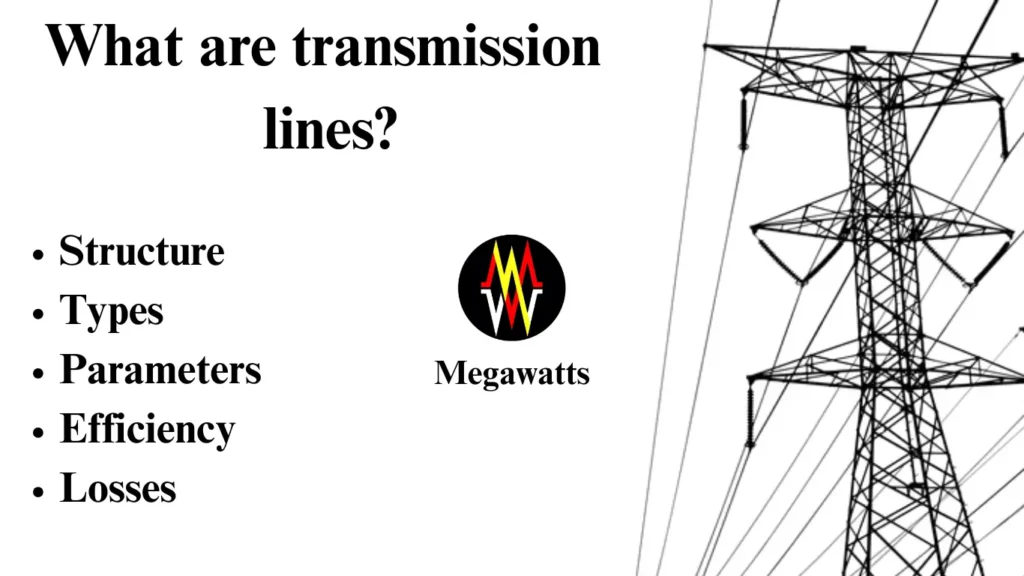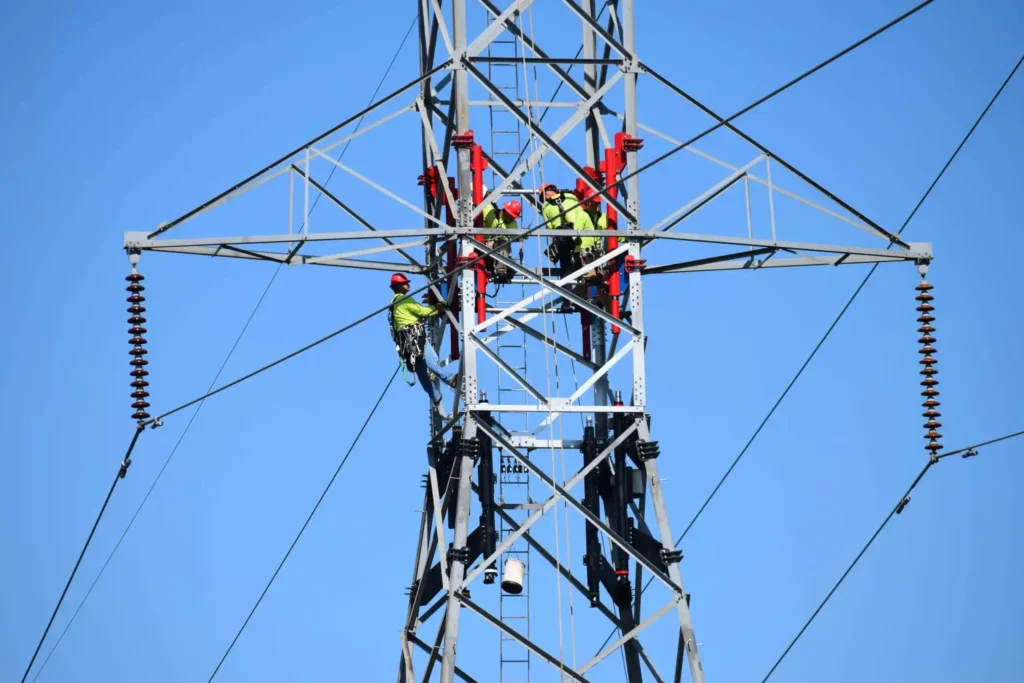
Table of Contents
What Are Transmission Lines?
Transmission lines are high-voltage power lines that carry electricity over long distances from generating stations to substations. These lines are essentially conductors, through which electricity flows, ensuring that energy, which is produced in remote generating plants, reaches urban and rural load centers with minimal losses.
Structure of Transmission Lines
Transmission lines comprise of several key components:
- Conductors: These are mostly made of aluminum or copper, in single, double, or quad configurations, and are responsible for carrying the electrical current. Aluminum is often preferred due to its lower cost and weight, however, it has a lower conductivity than copper.
- Insulators: These materials are made of porcelain or polymer, which prevents the high-voltage electricity from grounding by keeping the conductors insulated/isolated from the tower’s structure.
- Towers and Poles: The transmission lines are normally supported by latticed towers or monopoles. Therefore, the reliability of the towers and their foundations has a direct impact on the reliability of the line. The towers support the conductor, insulators, and earth wire or Optical Fibre Ground Wire’s load and also help in maintaining vertical & horizontal Electrical clearances that is from the live conductor to ground (Phase-ground clearance) and live conductor to live conductor (Phase to Phase Clearance).
- Ground Wires: These wires run above the conductors and protect the transmission lines from direct lightning strikes by directing the lightning safely to the ground. Nowadays in place of the ground wires, OPGW is used which functions in grounding the lightning strikes and also supports the faster communication channels for digital signals.

Types of Transmission Lines
Transmission lines can be categorized based on several factors
Voltage Levels
Due to the high cost of Right of Way (ROW), the emphasis is on the transfer of a large quantum of power through an optimum corridor. This has resulted in an increase in the voltage levels of transmission lines and the use of narrow base towers & poles.
- High Voltage (HV): High-voltage lines operate in the voltage range of 11 to 33 KV. These are used for medium-distance power transmission of less than 80km.
- Extra High Voltage (EHV): Extra High Voltage lines operate at voltages between 66 kV and 400 kV, suitable for long-distance transmission between 80-230 Km.
- Ultra High Voltage (UHV): Operating at voltages above 400 kV, Ultra High Voltage lines are used for extremely long distances of more than 230 Km and to transmit bulk power.
Configuration
- AC (Alternating Current) Transmission Lines: AC lines are the most common type of transmission lines, these are efficient for transferring electricity over long distances at different voltage levels with the help of transformers. Although AC line’s maintenance costs are lower the transmission losses are more
- DC (Direct Current) Transmission Lines: DC lines are used for very long distances more than 700 Km and underwater power transmission because they have lower losses compared to AC lines over these distances. They are hence more economical for bulk power transmission. However, because of the use of a motor generator set for stepping down voltages, the transformation efficiency is usually lower than AC’s Transformers.
Medium
- Overhead Transmission lines: Overhead lines are the most visible, strung between towers using disc insulators. The conductors of the overhead lines are naked and live without insulation which reduces the cost of the transmission line. Also, the maintenance of overhead transmission lines is easier. However, the overhead transmission lines are more prone to faults as foreign objects like trees can fall upon the conductors and pollution harms the disc insulators.
- Underground Transmission lines: The underground lines are laid under the ground as the name suggests. Underground transmission lines are mostly used in densely populated or environmentally sensitive areas to reduce visual impact and weather-related issues. The cost of underground transmission cable is much higher which increases the cost of the line. They are usually safe from faults due to foreign objects, however, maintenance is not easy in case of a cable burst.
Transmission line parameters
There are four major parameters of transmission lines that are distributed uniformly along the line length, affecting the performance and they are:
Resistance of line: Resistance is the property of the conductor that opposes the current flow through the power line generating heat as a result. It is expressed in Ω/km.
The capacitance of line: In overhead lines, air acts as the dielectric medium. Therefore, the property by virtue of which energy is stored in the electric field between the conductors is the capacitance. The capacitance of the line affects the voltage, power factor and thus efficiency of long lines, however for short lines, the effect is minimal. It is expressed in farad/km.
The inductance of line: When current flows in a conductor, it generates a magnetic field. The change in the magnetic field caused by the change in current induces a voltage that then opposes the very current flowing through the conductor. This occurrence is called inductance and is expressed in Henry/km. Because of it the voltage drop and the reactive power loss is increased in the system.
Shunt conductance of the line: When alternating current flows in a conductor, some current tends to leak into the dielectrics, insulators, and surrounding atmosphere because of various imperfections. Therefore shunt conductance is the measure of leakage current that flows elsewhere other than the main conductors and is expressed as Siemens/km.
Transmission line losses
Resistive loss: These losses account for 50% of the losses because of the resistance of the line I2R which generates heat.
Capacitive loss: This loss is due to the distributed series capacitance of the line where energy is absorbed and released from the electric field continuously and gets lost as heat.
Inductive loss: This loss results from the distributed series inductance where the magnetic field is created and collapsed in every cycle.
Dielectric loss: It is the energy lost in the insulating media of the line. It is a significant loss in HV lines contributing to transmission inefficiency.
Efficiency of Transmission Line
The efficiency of the transmission line is the ratio between power received at one end of the line to power sent from the remote end of the line. In general, all transmission lines incur some loss of power while transmitting, this loss thus makes the power received always lesser than the power sent.
- Power Recieved = Power Sent – Losses
- Efficiency = (Power Sent – Losses) / Power Sent * 100%
- =Power Received / Power Sent * 100%
Challenges in the Management of Transmission Line
Managing the transmission lines involves several challenges:
Maintenance:
Ensuring that lines remain in good operating condition requires regular inspections and maintenance to prevent failures. Overhead lines are prone to faults as tree branches and foreign objects in the corridor can fall on the live conductors causing a ground fault. Hence, corridor clearance is a preventive maintenance check for the transmission lines.
Environmental Impact:
Constructing new transmission lines usually has significant environmental impacts. It includes natural habitat disruption as maintenance requires frequent corridor clearance, meaning cutting of trees and making space so that the electrical clearance phase to ground for designated voltage level can be maintained.
Weather and Natural Disasters:
Transmission lines are vulnerable to extreme weather conditions such as storms, heavy snowfall, and wildfires, which can cause damage to the conductors as well as the lattice tower structures as the wind load and snow loads cross the designed limits of the transmission lines.
Conclusion
Transmission lines are a critical component, which enables the delivery of electricity from power sources to consumers via substations forming a grid. As our energy needs grow and evolve, as per capita energy consumption is growing every year, the importance of maintaining and upgrading our transmission line infrastructure cannot remain underrated. However, efficient engineering and management can ensure a reliable and sustainable power supply for the time to come.
This article is a part of the Transmission line page, where other articles related to topic are discussed in details.
